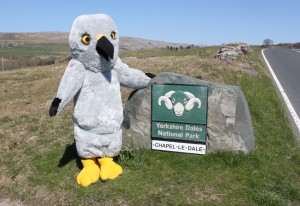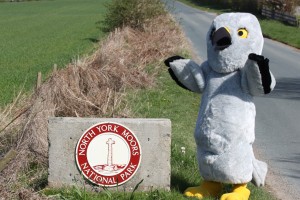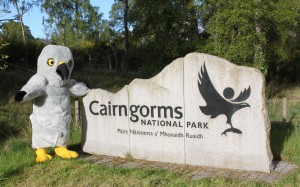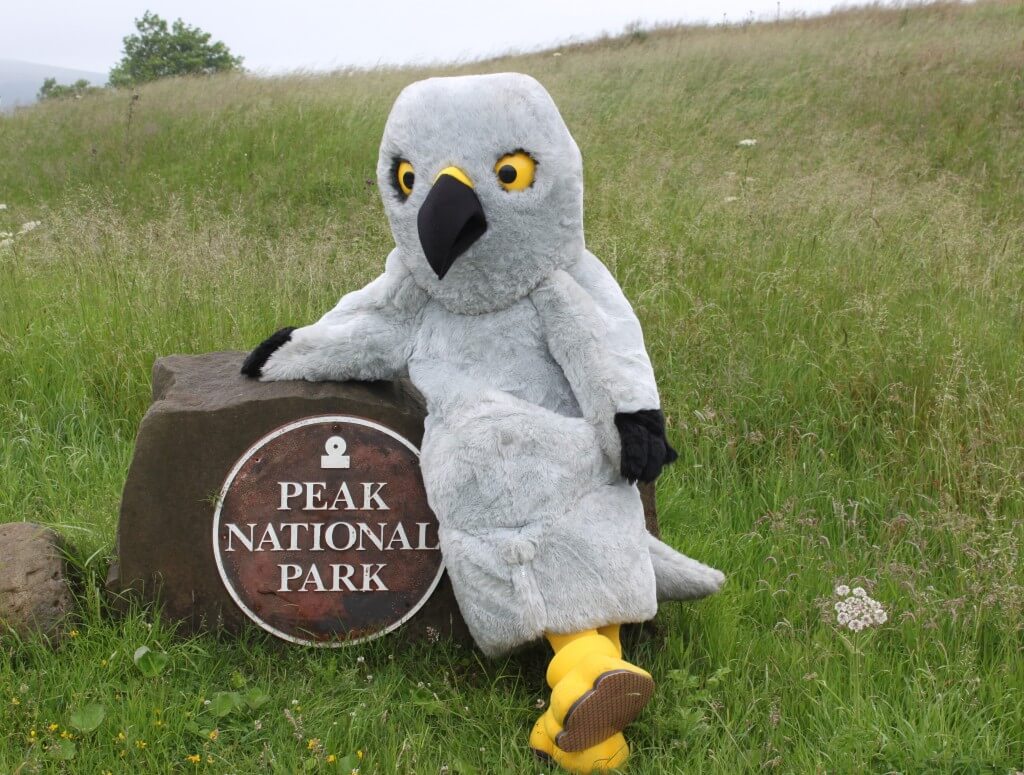![John James Audubon [Public domain], via Wikimedia Commons](https://markavery.info/wp-content/uploads/2015/10/Audubon-peregrinus.jpg)
There are just under 1500 Peregrine pairs in the UK and Isle of Man, and for the first time (since records began) more of them are in England (628 pairs (cf 471 in 2002)) than Scotland (509 pairs (cf 571 in 2002)). Numbers have gone up in Northern Ireland but down in Wales and the Isle of Man.
What seems to be happening is that Peregrines are doing well in the lowlands and badly in the uplands, and that’s why my lowland existence is much richer in Peregrines than it used to be and why my personal observations are that Peregrines are doing well, whereas the truth is that the national recovery of the Peregrine population is at a standstill.
An analysis of the Peregrine data at a more local level in Scotland, published in Scottish Birds (see Raptor Persecution Scotland blog), shows a similar pattern within North East Scotland. Peregrines have increased at coastal lowland sites but continued to decline in the uplands – including in the Cairngorms National Park.
I’ll be very interested to see what the results from the Peak District National Park will be in due course, where, of course, a special project has been running for five years with the aim of increasing the Peregrine population to 15 pairs by this year (in line with populations when the SPA was designated). I did see a Peregrine in the PDNP this year, but it wouldn’t be on my go-to list of places to go to see birds of prey. Given the information at the North of England Raptor Forum meeting last year, I’ll tell you now, there won’t have been 15 pairs of Peregrines in the target area this year.
 UK National Parks are a bit of a joke as far as wildlife is concerned. Set up, in England and Wales, by the 1949 National Parks Act (and the idea came up and was progressed whilst we were quite preoccupied by fighting a World War) they exist to ‘Conserve and enhance natural beauty, wildlife and cultural heritage’ and yet National Parks in England, mostly in the uplands, are as shockingly depauperate in top predators as the rest of the uplands – in fact, probably rather more so!
UK National Parks are a bit of a joke as far as wildlife is concerned. Set up, in England and Wales, by the 1949 National Parks Act (and the idea came up and was progressed whilst we were quite preoccupied by fighting a World War) they exist to ‘Conserve and enhance natural beauty, wildlife and cultural heritage’ and yet National Parks in England, mostly in the uplands, are as shockingly depauperate in top predators as the rest of the uplands – in fact, probably rather more so!
Peregrines, Hen Harriers and Goshawks are all persecuted like mad in National Parks whilst the NP Authorities wring their hands and cosy up to the grouse shooters who are major ‘stakeholders’ in their lives. English National Parks in the uplands, are crime scenes that are simply shocking.

As you enter the North York Moors, Yorkshire Dales or Peak District National Parks the entrance sign should read ‘Raptor free zone – turn round and go back to your cities if you want to see any birds of prey!’ and this would help meet a second aim of NPs which is to ‘Promote opportunities for the understanding and enjoyment of the special qualities of national parks by the public’. The special qualities of English upland National Parks is that they are grouse farms where birds of prey are not tolerated and the NP authorities have failed to clamp down on crime. Perhaps every car park in these three National Parks ought to have a notice apologising for the lack of wildlife in them, but saying that the relationships with important stakeholders who shoot chicken-like birds for fun are perfectly satisfactory.
 At least in Scotland the Cairngorms National Park has spoken out on this subject, although deeds are rather more important than words, but words are pretty thin on the ground down here in England.
At least in Scotland the Cairngorms National Park has spoken out on this subject, although deeds are rather more important than words, but words are pretty thin on the ground down here in England.
In May 2014 the Convenor of the Cairngorms National Park Authority complained to the Scottish Environment Minister that continued raptor persecution in the area “threatens to undermine the reputation of the National Park as a high quality wildlife tourism destination” (see here). Down here in England we don’t even get that type of rhetoric but we do have National Parks whose reputations are tarnished – unless you fancy a day’s grouse shooting in which case they are the places to go.
Governments north and south of the England/Scotland border fail to have a grip on this issue. It is perfectly clear that Defra does not give a damn about wildlife crime in or out of National Parks – inaction speaks louder than words.
If you sign this e-petition then we might get a debate in parliament and someone might suggest that we start tackling the problems of driven grouse shooting by banning it in our National Parks.
[registration_form]
I’m actually shocked at how low the number of breeding peregrines is, not exactly a mega predator I had been expecting there were 5 or 6,000 pairs on the go, not 1,500. I have heard that peregrines are roosting in my town (plus for a treat please look at this video – https://www.youtube.com/watch?v=FtARWKXEHeE), and recently a sparrow hawk was photographed feeding on a pigeon in the high street, buzzards are now one of the ‘common’ species in my local park and hopefully red kites might start moving into the area too we have a kite feeding site, Ardgaty, just a few miles up the road. Towns are becoming the havens for raptors, not our national parks.
I too was surprised and disheartened at this low total. Like you, Mark, I see them regularly in Leeds city centre (and Manchester and London when I lived there) and had assumed that the increases in the city were matched by growth more widely.
One small contribution I made this morning: I received an email from Jeremy Corbyn (a mass mailout rather than a personal one!) asking for more questions from the public that he could take to PMQs this week. I submitted a question about the Government’s inaction on wildlife crime, particularly raptor persecution, and included a link to your petition. I’d be stunned if that appeared on Wednesday, but we can hope!
I had a drive round the North York Moors a couple of years ago. Most of it is a barren wasteland. The Moors round Sheffield are much better with quite a lot to see. But if you go north it turns back into a barren wasteland. Basically where there are grouse moors there is little other life. The RSPB have taken over management of parts of the South Yorkshire/Derbyshire Moors so there is hope in those areas. Other land is controlled by the National Trust, indeed it is believed that the gamekeeper responsible for goshawk nest destruction round Ladybower/Derwent Reservoirs and the destruction of Peregrine nests round Alport Castle works on National Trust land. It is a bit of a bone of contention locally that the National Trust have been inactive on this.
On the question of the National Trust, I contacted them a couple of years ago, after a high profile case where a keeper was caught by the RSPB using a crow trap to catch and kill birds of prey on NT land. They told me unequivocally that shooting licences on NT land was tied to conservation targets for encouraging raptors and other wildlife and to an absence of criminality. Whether that was truth or hogwash, whether it is working or not, I don’t know – but that is what they claimed.
The phrase ‘raptor free zone’ first appeared on signage at several key entrance sites into the Forest of Bowland in 2011. This was one year after Natural England withheld licenses which had previously been issued to the North West Raptor Group to monitor hen harriers and peregrines in that region for over four decades. It is perhaps significant that the removal of those licenses then facilitated the accelerated killing of raptors in Bowland throughout the last four years. Remove the expertise gained by individuals with over 40 years of on site experience in the Forest of Bowland provided gamekeepers a free hand, as demonstrated by what has now been allowed to take place.
In 2009, twenty five Bowland peregrine territories were examined by licensed members of the NWRG. Seventeen territories were found occupied, 6 of these sites failed following the disappearance of eggs and chicks. A total of eleven territories were productive fledging twenty four young. This result was considered by the NWRG to have been a very poor breeding season.
This year (2015) only 6 breeding attempts were recorded in Bowland, only a single nesting pair was successful after one nest was destroyed, adult birds disappeared and several clutches of eggs vanished. These figures graphically highlight the current trend of raptor persecution still taking place upon moorland in northern England where red grouse are shot.
Since Natural England took the fateful political decision to revoke peregrine licenses from the NWRG for use in Bowland 5 years ago, no less than 17 peregrine territories established within the Forest of Bowland prior to 2009 have either been destroyed completely, rendering their future use impossible, or are currently known to have been abandoned.
If we are going to bring about an end to the killing of raptors on grouse moors, we need many more experienced people on the ground to counter what is being undertaken with impunity in areas like the Forest of Bowland not less.
This was a catastrophic blunder by Natural England and should never have been allowed to happen. If Natural England has any credibility left at all and has any real sincerity regarding the protection of raptors on the Forest of Bowland, then they should re-instate NWRG licenses immediately.
Our national parks are a joke, compared to those in other countries. Largely privately owned and full of farms or shooting estates, is it any wonder there is no wildlife.
Interesting that Carlisle was one of the early towns to have its Peregrines removed. 2 pairs nested with one on a BT mast. When I complained of their removal a spokesman for BT claimed that local hens were being predated by them and they had to go. I think racing pigeons in Carlisle must have grown so big that they looked like hens!
The removal of licenses from the local raptor group working in Bowland by Natural England was a huge miscalculation by the governments wildlife advisor. I was told this decision then resulted in local gamekeepers having a field day. What I find interesting was the loss of licenses was not the result of any wrong doing by any group member, quite the reverse in fact, they were withheld because the group had had the audacity to publish details of raptor persecution in Bowland on the Raptor Politics blog. These details having been made public, so the story goes, caused embarrassment to Natural England and local estates together with their gamekeepers.
Like Tom Willis earlier, I also received an e-mail requesting a question for Jeremy Corbyn to ask the Prime Minister. That question is, Are the Government going to ban driven grouse shooting? Unlikely to be asked I know and it certainly will not be answered on the day but, just in case, anyone from the Government care to answer now?